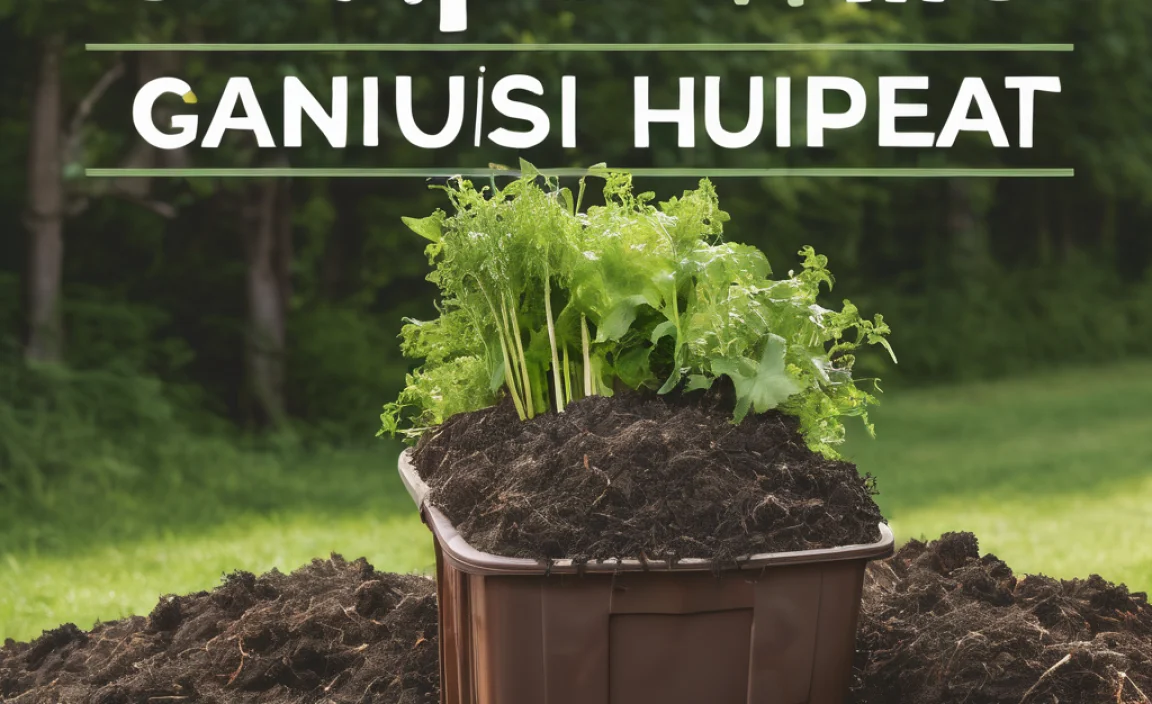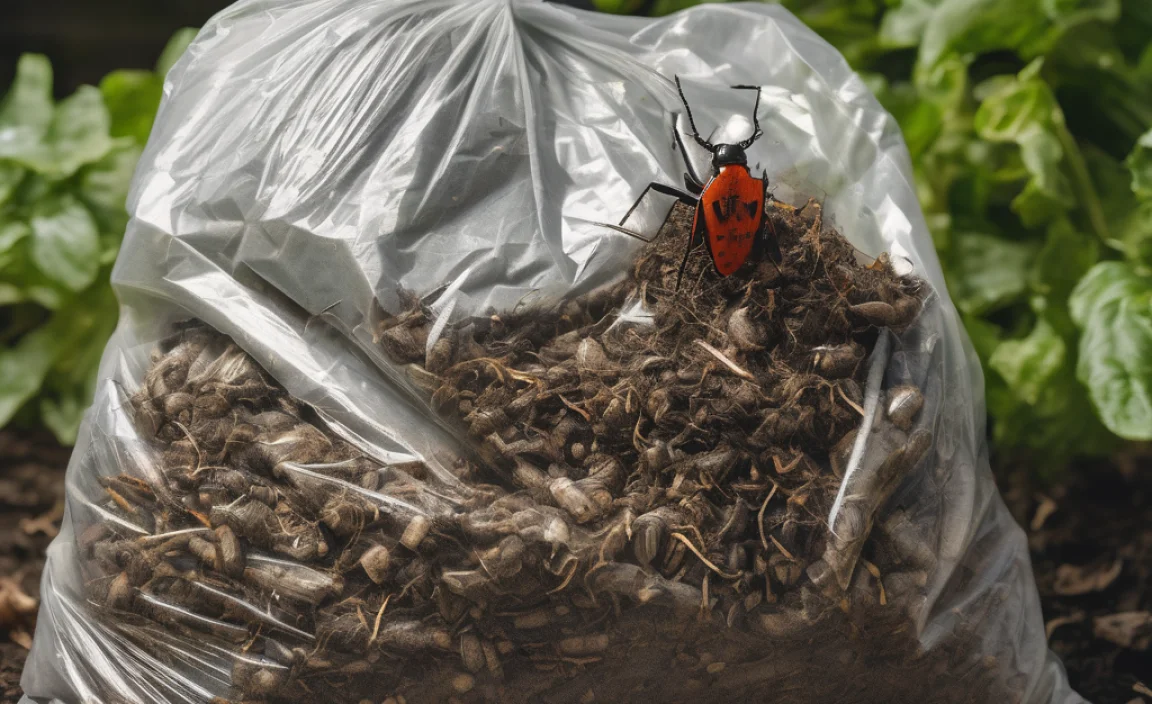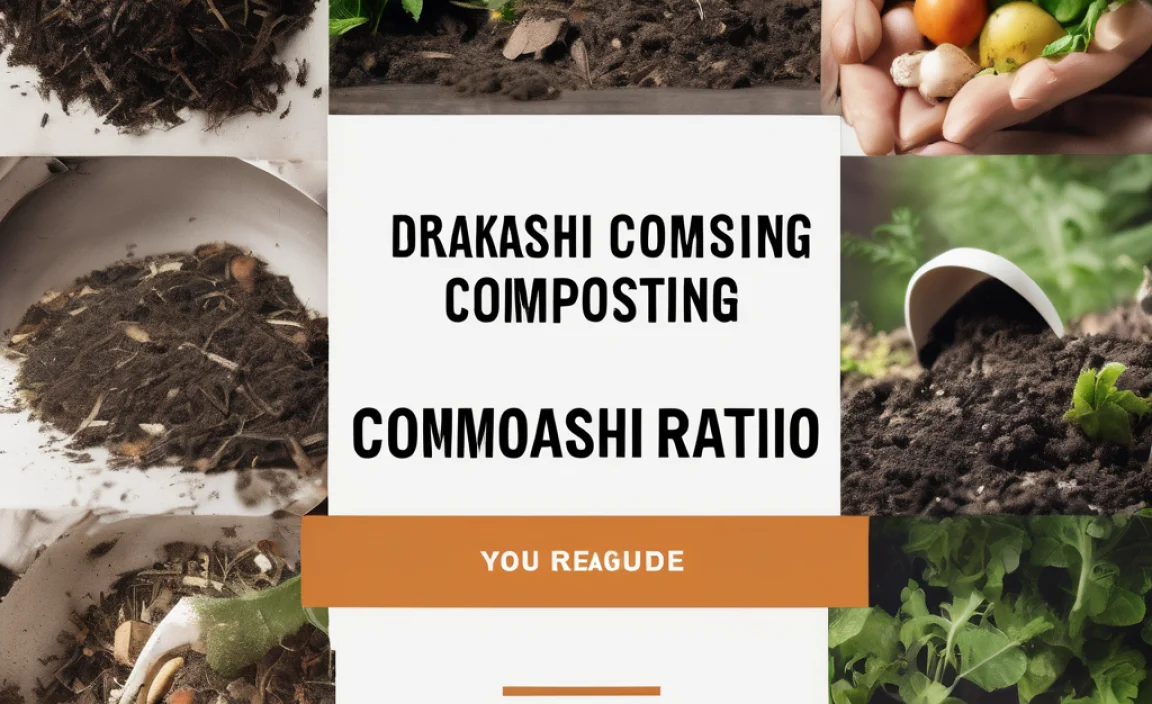Making compost tea can feel like a magic trick for your garden. It’s a liquid gold that feeds your plants and boosts soil health. But sometimes, things go a bit wrong, and your precious brew turns stinky or ineffective. Don’t worry! Many gardeners run into these same compost tea problems. We’re going to walk through them, one by one, and I’ll show you exactly how to fix them. You’ll be brewing up perfect, powerful compost tea in no time.
Compost Tea Problems: Essential Solutions to Brew Better
Hey there, greener thumb warriors! Troy D Harn here from TopChooser, back to make your gardening life a little easier. We’ve all been there, right? You’re excited to give your plants a special treat with some homemade compost tea. You follow the steps, use your best compost, and then… yikes. Something’s not adding up. Maybe it smells like a rotten egg, or perhaps your plants aren’t looking any perkier after you’ve watered them with it. These are common “compost tea problems,” and they can be super frustrating when you’re trying to do something good for your garden.
But here’s the good news: these issues are usually fixable with a few simple tweaks. It’s not rocket science, just a bit of understanding about what’s happening in that brewing bucket. We’ll dive into the most common compost tea problems and, more importantly, the straightforward solutions to get you back on track. Think of this as your friendly guide to brewing the best compost tea your garden has ever seen!
What is Compost Tea, Anyway?
Before we tackle the problems, let’s quickly cover what compost tea is all about. Simply put, compost tea is a liquid fertilizer made by steeping high-quality, finished compost in water. This process extracts beneficial microorganisms (like bacteria and fungi) and soluble nutrients from the compost. When you water your plants with it, these microbes and nutrients get delivered directly to the soil and plant roots, promoting healthier growth and increasing plant resilience.
It’s like giving your plants a probiotic boost! The key is using good compost and brewing it correctly. When it’s done right, it’s a fantastic, natural way to supercharge your garden.
Common Compost Tea Problems and Their Solutions
Let’s get down to business. Here are the most frequent issues folks encounter with their compost tea brews and exactly what you can do about them.
Problem 1: The Stinky Brew (Anaerobic Conditions)
This is the big one. If your compost tea smells overwhelmingly foul, like sulfur or rotten eggs, it means it’s gone anaerobic. Anaerobic means “without air.” This happens when there isn’t enough oxygen in the brew, and the “wrong” kinds of microbes (the smelly, unhelpful ones) start to take over.
Why it Happens:
- Not Enough Aeration: This is the most common culprit. If your aquarium pump isn’t strong enough, or your air stones are clogged, the water isn’t getting enough oxygen.
- Over-Composting or Poor Compost Quality: If the compost used is too wet or not fully finished, it can contribute to anaerobic conditions in the brew.
- Brewing Too Long: Leaving the tea to brew for too many days without adequate aeration can also lead to smells.
- Using the Wrong Ingredients or Too Much: Adding too much compost to the water can make it dense and harder to oxygenate.
Essential Solutions:
- Boost Aeration: This is your first line of defense. Ensure your air pump is strong enough for the volume of your brew. Use multiple air stones if needed, and make sure they’re not clogged. You want a vigorous bubbling action! An aquarium pump rated for 20-40 gallons is usually a good starting point for a 5-gallon bucket. For larger brews, you’ll need a more powerful pump.
- Use High-Quality, Finished Compost: Start with the best. Your compost should be crumbly, earthy-smelling, and completely broken down. Avoid compost that has lots of un-decomposed material or smells bad on its own. Learning to make great compost yourself is step one! Check out resources on proper composting techniques from places like the EPA for general waste reduction and composting principles.
- Brew for the Right Amount of Time: Typically, 24 to 48 hours is ideal. Any longer, and you risk the beneficial microbes dying off or anaerobic bacteria causing problems, especially if aeration isn’t perfect.
- Get the Compost-to-Water Ratio Right: A good starting point is about 1-2 cups of compost per 5 gallons of water. Too much compost can create a dense mixture that’s hard to oxygenate.
- Add a “Food Source”: Some gardeners add a small amount of unsulfured molasses or fish hydrolysate to feed the beneficial microbes. This can help to boost microbial activity. However, if you don’t aerate enough, this extra food can also contribute to smells. So, aeration is still king!
- Strain and Use Immediately: If you smell it, use it as quickly as possible. Don’t let a slightly stinky brew sit around.
Problem 2: The Weak or Ineffective Brew
You brewed your tea, it doesn’t stink, but you’re not seeing the amazing results you expected. Your plants seem just as they were before. What gives?
Why it Happens:
- Poor Quality Compost: If your starting compost lacks beneficial microbes or nutrients, your tea will too.
- Killed Off the Microbes: This can happen if you use chlorinated water (the chlorine can kill beneficial microbes) or if the water temperature is too extreme (too hot or too cold).
- Brewing Time Too Short: The microbes need enough time to multiply and extract nutrients.
- Not Enough Microbes in the Compost: Some composts are more “dead” than others.
- Incorrect Application: Applying the tea at the wrong time or in the wrong way can reduce its effectiveness.
Essential Solutions:
- Use High-Quality, “Living” Compost: Your compost should be teeming with life. If it smells sweet and earthy, that’s a good sign.
- Use Dechlorinated Water: Chlorine in tap water can be harmful to the microbial life in your tea. To dechlorinate, let your water sit out in an open container for 24 hours, or use a simple water filter. Rainwater is also an excellent choice if you can collect it.
- Maintain Ideal Water Temperature: Aim for water temperatures between 60-80°F (15-27°C). Avoid brewing in direct sunlight or freezing conditions.
- Brew for the Correct Duration: 24-48 hours is usually optimal for microbial multiplication.
- Add a Microbial Stimulant: As mentioned, a little unsulfured molasses can feed the microbes and encourage their growth. Other options include fish hydrolysate or humic acids.
- Apply Correctly: Water your plants directly at the base, especially the root zone, or use a foliar spray early in the morning or late in the evening. Applying when the sun is strong can burn the leaves.
Problem 3: The Slimy Brew
Sometimes, your compost tea can become slimy or have stringy, gooey-looking material. This often points to an over-proliferation of certain types of bacteria, usually due to a lack of sufficient aeration or overcrowding of microbes.
Why it Happens:
- Insufficient Aeration: Not enough oxygen allows certain slimy bacterial colonies to dominate.
- Too Much “Food” (Molasses): Adding too much molasses can fuel bacterial growth excessively.
- Overcrowding: Using too much compost relative to the water volume.
Essential Solutions:
- Increase Aeration: This is the most critical fix. Ensure vigorous bubbling throughout the brew cycle.
- Adjust “Food” Amounts: If you’re adding molasses, use it sparingly. A common recommendation is 1-2 tablespoons per 5 gallons.
- Check Compost-to-Water Ratio: Ensure you’re not using too much compost. A ratio of about 1:5 (compost to water by volume, loosely packed) is often cited.
- Use Sooner Rather Than Later: If it’s only slightly slimy and doesn’t smell foul, it’s probably still usable. Apply it soon after brewing.
Problem 4: Mold or Fungus Growth on Top
Seeing a fuzzy layer on top of your compost tea might look alarming, but it’s not always a bad sign. It often indicates the presence of fungi, which can be very beneficial for gardens, especially for breaking down organic matter and improving soil structure. However, if it’s excessive or accompanied by foul odors, it could indicate an imbalance.
Why it Happens:
- Presence of Fungal Spores: Fungi are naturally present in compost and the air.
- Insufficient Aeration: While some fungi like a little bit of air, too little can lead to anaerobic conditions and negative fungal/bacterial imbalances.
- Not Stirring/Agitating Enough: If using a passive method or if the aeration isn’t consistent, a surface film can develop.
Essential Solutions:
- Observe the Color and Smell: If the film is white, tan, or light brown and the brew smells earthy, it’s likely beneficial fungi. If it’s black, green, or has a foul odor, it could be undesirable mold and points to other issues like poor aeration.
- Increase Aeration: Ensure consistent and vigorous bubbling to keep the surface agitated and prevent stagnation.
- Strain Well: When straining your compost for brewing, ensure you’re not leaving behind large, undigested organic chunks that could promote mold growth.
- Use the Tea: Unless it smells truly rank and appears unhealthy, the fungal growth is likely beneficial. Strain out any large clumps of mold and use the tea.
Problem 5: Not Enough Microbes (Low Microbial Count)
Even if your tea smells good and looks okay, it might not be as potent as you’d hoped if the microbial count is low. This means you’re probably not getting all the benefits for your plants.
Why it Happens:
- Using “Dead” or Old Compost: Compost that has been stored for a long time or has been improperly composted might have lost its microbial life.
- Using Recycled “Spent” Tea Grounds: Repeatedly using the same compost material can deplete its microbial and nutrient content.
- Using Non-Organic or Sterilized Compost.
- Water Quality Issues: Chlorinated water can reduce microbial populations.
Essential Solutions:
- Use Fresh, High-Quality Compost: The fresher and more alive your compost is, the more microbes you’ll extract. Aim for compost that’s actively “breathing” and smells rich.
- Use Fresh Compost with Each Brew: Don’t try to reuse the same compost material indefinitely.
- Add a Microbial Booster: Incorporate ingredients known to support microbial life, such as a small amount of finished worm castings or a commercial microbial inoculant.
- Feed the Microbes: A touch of unsulfured molasses or even a bit of raw oats can provide food for the microbes during brewing, helping them multiply.
- Ensure Proper Brewing Conditions: Ideal water temperature and adequate oxygen are crucial for microbial growth.
A Quick Guide to Brewing Success (and Avoiding Problems)
To sum up, brewing great compost tea comes down to a few key elements. Keeping these in mind will help prevent most common compost tea problems.
| Key Brewing Element | What to Aim For | Potential Problem if Ignored |
|---|---|---|
| Compost Quality | Finished, rich, earthy-smelling, full of life. | Weak brew, no benefits, potential for foul odors. |
| Water Quality | Dechlorinated, rain, or aged tap water. | Kills beneficial microbes, leading to weak tea. |
| Aeration | Vigorous bubbling, constant oxygen supply. | Anaerobic conditions, foul smells, slimy brew. |
| Brewing Time | 24-48 hours. | Too short: not enough microbes. Too long: microbes die off, potential for imbalance. |
| Temperature | 60-80°F (15-27°C). | Too hot/cold can kill microbes or slow down activity. |
| Ratio (Compost:Water) | Approx. 1:5 by volume (loosely packed). | Too much compost can lead to poor aeration and density. |
Compost Tea Brewing Equipment Basics
Getting the right gear can make a big difference in avoiding issues. You don’t need fancy equipment, but a few things are essential:
- A Brew Vessel: A clean 5-gallon bucket is a classic choice. Avoid buckets that previously held harsh chemicals.
- Aquarium Air Pump: Choose one strong enough for your bucket size. For a 5-gallon bucket, a pump rated for 20-40 gallons is usually sufficient.
- Air Stones: These create fine bubbles to maximize oxygen transfer. You might need one or two for a 5-gallon bucket.
- Tubing: To connect the pump to the air stones.
- Strainer Bag: A mesh bag (like a paint strainer bag, onion sack, or specialized compost tea bag) to hold your compost. This makes cleanup easy and prevents large particles from clogging sprayers.
- Scale or Measuring Cups: To accurately measure your compost.
- Optional: Thermometer: To check water temperature.
For those who want to save a bit of time and effort, there are also ready-made compost tea brewers available, but a DIY setup works perfectly well!
Applying Your Compost Tea
Once your tea is ready and problem-free, how do you use it? The goal is to get those beneficial microbes and nutrients onto and into the soil where plants can use them.
- As a Soil Drench: This is the most common method. Water your plants directly around the base, soaking the soil. This encourages root growth and feeds soil organisms.
- As a Foliar Spray: Dilute the tea (often 1:1 with water, though some use it undiluted) and spray it directly onto the leaves of your plants. This can help provide nutrients and boost disease resistance. Spray early in the morning or late in the evening to avoid burning the leaves and to allow microbes to colonize before the sun gets too intense.
Important Note: Compost tea is best used fresh. The beneficial microbes have a limited lifespan once removed from their brewing environment. Aim to use it within 4-6 hours of finishing the brew. If it’s been aerated properly and kept cool, it might last up to 24 hours, but fresher is always better!
Frequently Asked Questions about Compost Tea Problems
Here are some common questions folks have when things go awry with their compost tea.
Q1: My compost tea smells bad, but I aerated it a lot. What else could be wrong?
A: Even with aeration, if your compost quality is poor (not fully finished, contains pathogens, or has too many un-decomposed materials), it can still lead to bad smells. Also, check if the compost itself is contributing to the odor before you even start brewing. Using too much compost can also make it hard to get enough oxygen to all parts of the brew.
Q2: Can I reuse the compost solids left in the bag after brewing?
A: It’s generally not recommended to reuse the same compost solids for multiple brews. Most of the readily available nutrients and microbes have been extracted. Reusing them will likely result in a weaker tea. However, these spent grounds are still excellent for adding back to your compost pile or directly to garden beds as a soil amendment.
Q3: How quickly should I see results after using compost tea?
A: Results can vary. You might see a quick green-up with foliar sprays, but the deeper soil health benefits – increased microbial activity, better nutrient cycling, and improved plant resilience – develop over time. Consistent application every 2-4 weeks throughout the growing season is often recommended for best results.</p

I am passionate about home engineering. I specialize in designing, installing, and maintaining heating, ventilation, and air conditioning systems. My goal is to help people stay comfortable in their homes all year long.



